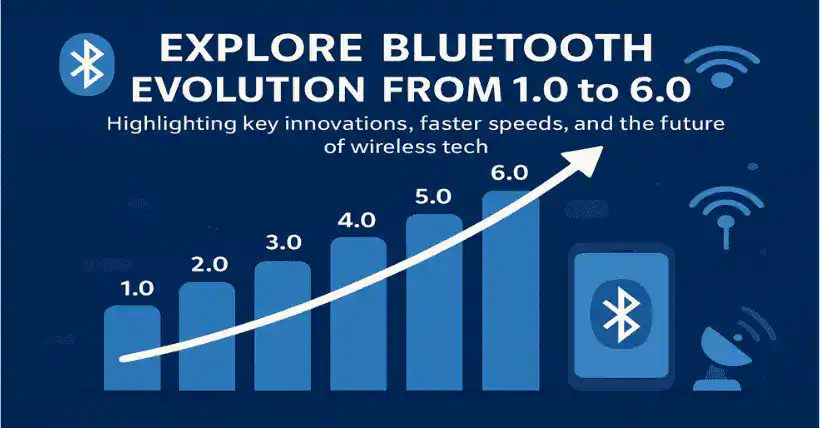Since Bluetooth technology was proposed by Ericsson in 1994, it has become one of the core technologies for short-range wireless communication. From the initial simple data transfer to today’s smart connections supporting high speed, low power consumption, and multi-device collaboration, Bluetooth protocol versions have continuously evolved, offering users a more convenient experience. This article will guide you through the development of Bluetooth protocols and their application scenarios.
1. Bluetooth 1.0 / 1.2: The Beginning of Wireless Communication
Release Date: 1999 (Bluetooth 1.0)
Features:
- Low transmission rate (about 1 Mbps)
- Basic audio and data transfer (e.g., early Bluetooth headsets, file transfers)
- Weak anti-interference ability, easily affected by WiFi signals
Application Scenarios: Early wireless headsets, file transfers between mobile phones
2. Bluetooth 2.0 + EDR: Speed Enhancement
Release Date: 2004
Features:
- Introduction of EDR (Enhanced Data Rate), transmission rate increased to 3 Mbps
- Power consumption optimized, better suited for mobile devices
Application Scenarios: Wireless keyboards, mice, stereo headsets
3. Bluetooth 3.0 + HS: The High-Speed Transmission Era
Release Date: 2009
Features:
- Combines WiFi technology, theoretical transmission speed up to 24 Mbps (still relies on Bluetooth pairing)
- Suitable for large file transfers, such as HD images and videos
Application Scenarios: High-speed data transfer, multimedia sharing
4. Bluetooth 4.0 (BLE): The Low Power Revolution
Release Date: 2010
Features:
- Introduction of BLE (Bluetooth Low Energy), greatly reduced power consumption
- Suitable for IoT devices such as smart bands and sensors
- Moderate transmission rate, but significantly improved battery life
Application Scenarios: Wearable devices, smart homes, health monitoring
5. Bluetooth 5.0: Further, Faster, More Stable
Release Date: 2016
Features:
- Transmission distance increased to 300 meters (theoretical, in open environments)
- Double the speed (2 Mbps)
- Supports broadcast mode, allows connection to more devices
Application Scenarios: Smart homes, beacon positioning, wireless audio
6. Bluetooth 5.1 / 5.3: Precision Positioning and Optimization
Release Date: 2019–2021
Features:
- 5.1: Added direction finding (AoA/AoD) to improve positioning accuracy
- 5.2: Enhanced LE Audio, supports synchronized audio for multiple devices
- 5.3: Improved connection stability and reduced latency
Application Scenarios: AR/VR devices, true wireless earbuds (TWS), indoor navigation
7. Bluetooth 5.4 (2023): A New Standard for the Future of IoT
Latest Features:
- Strengthened encryption and security
- Supports more complex Mesh networks
- Optimized for large data transfer (e.g., medical devices)
Application Scenarios: Industrial IoT, smart cities, remote healthcare
8. The Future of Bluetooth: Towards the Era of 6.0
According to industry forecasts, Bluetooth 6.0 will further integrate AI technology, enhance anti-interference capabilities, and may support higher-bandwidth real-time transmission, providing stronger support for scenarios such as AR/VR, vehicle networking, and smart factories.
From 1.0 to 5.4, each upgrade of Bluetooth technology has made wireless connections smarter and more efficient. Whether it’s everyday wireless headsets or cutting-edge IoT ecosystems, the Bluetooth protocol continues to push boundaries. In the future, with the arrival of 6.0, we may enter a new era of “wireless interconnection of everything.”

Disclaimer:
- This channel does not make any representations or warranties regarding the availability, accuracy, timeliness, effectiveness, or completeness of any information posted. It hereby disclaims any liability or consequences arising from the use of the information.
- This channel is non-commercial and non-profit. The re-posted content does not signify endorsement of its views or responsibility for its authenticity. It does not intend to constitute any other guidance. This channel is not liable for any inaccuracies or errors in the re-posted or published information, directly or indirectly.
- Some data, materials, text, images, etc., used in this channel are sourced from the internet, and all reposts are duly credited to their sources. If you discover any work that infringes on your intellectual property rights or personal legal interests, please contact us, and we will promptly modify or remove it.



